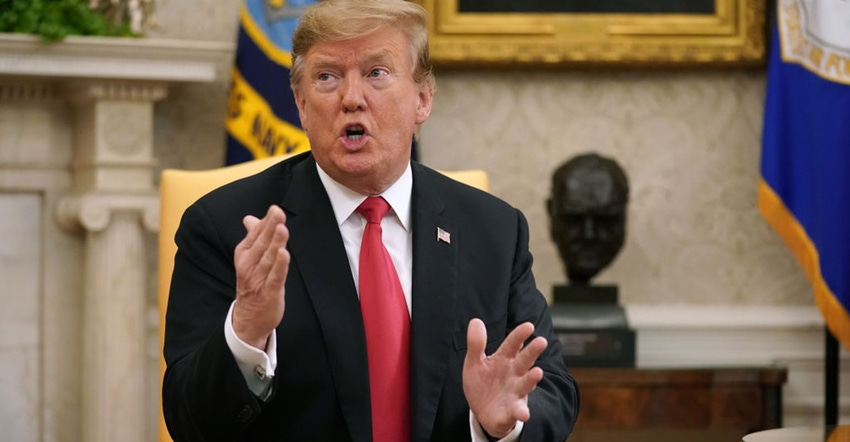
by Alyza Sebenius
President Donald Trump will visit a stretch of border wall in California on Friday, capping a week of heated threats against Mexico over undocumented migration and the flow of illegal drugs.
In his third trip to the border this year, Trump will view a portion of border wall in the city of Calexico and meet with local law enforcement, a setting he typically uses to reiterate his promises to crack down on undocumented immigration.
The visit comes at the end of a tumultuous week that laid bare Trump’s growing frustration and limitations in controlling the U.S. southern border. The administration’s botched efforts have ranged from an attempt to deter migration by separating migrant children from their families to ultimatums against Mexico that have proved too costly to enforce.
One such threat came at the end of last week, when Trump said he would immediately close the border unless Mexico stemmed the flow of migration from Central and South America.
Changing Course
But by Thursday -- after an outcry from lawmakers and businesses alike that closing the border would bring economic calamity -- Trump had changed course. Instead, he abruptly said he’d likely impose tariffs on cars imported from Mexico if the country didn’t stanch the flow of migrants and illegal drugs into the U.S. within a year.
“I don’t think we’ll ever have to close the border because the penalty of tariffs on cars coming into the United States from Mexico at 25 percent will be massive,” Trump told reporters at the White House on Thursday.
Trump has hammered on immigration since the day he launched his presidential campaign in 2015. It has remained one of the most divisive issues of his presidency and will certainly feature prominently in his 2020 re-election campaign. That’s been foreshadowed by rising tensions in recent weeks, as increasing numbers of migrants -- including an unprecedented number of families and unaccompanied children -- have sought to cross into the U.S.
Homeland Security Secretary Kirstjen Nieslen said Monday that the administration will expedite the return of migrants to Mexico and speed up plans to deploy additional personnel to the border. Nielsen, who visited the border and met with officials in Texas and Arizona this week, canceled plans to attend security meetings in France this week in order to accompany Trump to Calexico, an official said.
“Next step is to close the Border!,” Trump tweeted March 29, calling on Mexico to stop migrants trying to reach the U.S., where “detention areas are maxed out.” But by Tuesday, he suggested on Twitter that Mexico was heeding his demand: “Mexico is apprehending large numbers of people at their Southern Border.”
Senator Jeff Merkley, an Oregon Democrat, told CNN Friday morning that Trump is to blame for the recent surge of people trying to cross the border into the U.S. by creating a self-fulfilling crisis.
“More are coming because of the president’s threats to use a national emergency to seal the border,” Merkley said.
Mexican Foreign Minister Marcelo Ebrard told reporters he didn’t know what prompted Trump’s message. Mexico’s migration policy has been consistent under President Andres Manuel Lopez Obrador, and there are no plans to change it, Ebrard said.
‘Great Job’
The number of migrants Mexico has returned to their home countries in January and February hasn’t changed much since last year. But Trump said that Mexico had refused entry to 1,000 U.S.-bound migrants per day since Tuesday.
“Mexico in the last four days has really done a great job on their southern border with Honduras, with Guatemala, with El Salvador, of grabbing and taking and bringing people back to their countries because they’re not gonna come to our country, we’re not going to allow it,” Trump said.
Closing U.S. entry points would have far-reaching economic consequences and hinder $1.7 billion in daily cross-border trade. Supply chains are closely integrated between the two countries, particularly in the auto industry. Car makers and farmers, who have already been hit by Trump’s trade war with China, would suffer. The price of avocados already spiked this week.
The U.S., Canada and Mexico last year concluded a revision of the North American Free Trade Agreement that would limit U.S. auto tariffs against Mexico. The agreement is pending congressional approval. Trump indicated that he didn’t care whether the tariffs he threatened would violate the new trade deal, called the U.S.-Mexico-Canada Agreement, saying Mexico would have to “live with it.”
Putting tariffs on Mexico-built autos would risk hurting companies including General Motors Co. and Fiat Chrysler Automobiles NV, which import key models from the country including Chevrolet, GMC and Ram full-size pickups. The U.S. imported 41% more vehicles last year than in 2014, according to Commerce Department data.
Trump has also sparred with Congress on border security and is calling on lawmakers to revamp what he calls the worst immigration laws in the world. In February, he declared a national emergency to fund the construction of a border wall, after causing a 35-day government shutdown, the longest in U.S. history, in a failed bid to get Congress to allocate the money. Lawmakers voted to oppose the declaration, prompting Trump to issue the first veto of his presidency.
--With assistance from Kathleen Miller.
To contact the reporter on this story: Alyza Sebenius in Washington at [email protected]
To contact the editors responsible for this story: Alex Wayne at [email protected] Joshua Gallu
© 2019 Bloomberg L.P
About the Author(s)
You May Also Like




